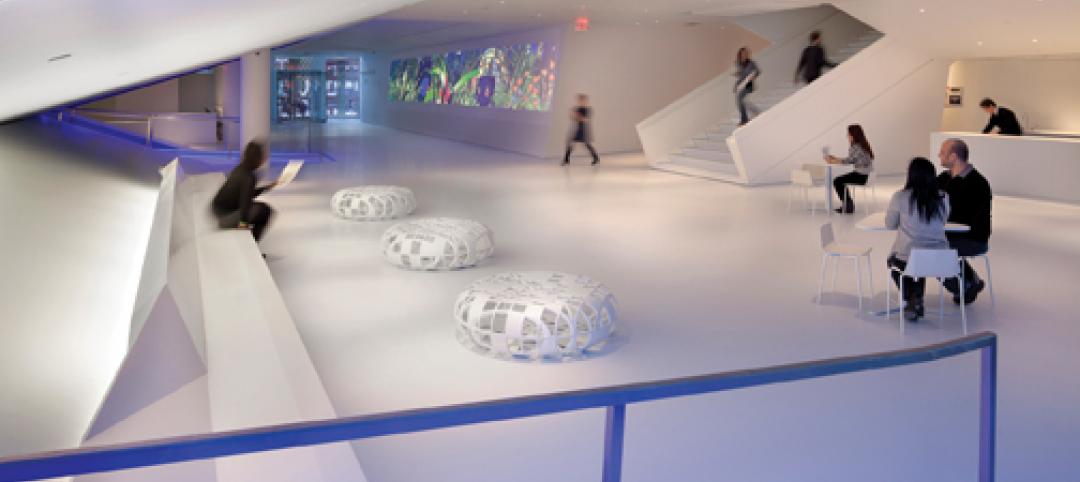The commercial real estate industry is increasingly focused on the needs of small firms where job growth is outpacing larger firms by nearly five to one, according to Emerging Trends in Real Estate 2016, co-published by PwC US and the Urban Land Institute (ULI).
Now in its 37th year, Emerging Trends in Real Estate provides outlooks for the real estate and land use industry. It includes interviews and survey responses from more than 1,800 leading real estate experts, including investors, fund managers, developers, property companies, lenders, brokers, advisers, and consultants.
“The real estate industry's traditional focus on big cities and large employers is shifting significantly as small businesses emerge as the growth engine for the U.S. economy,” said Mitch Roschelle, partner, U.S. real estate advisory practice leader, PwC. “This is creating disruption in the office sector as it finds ways to create new space models to accommodate these employers.”
10 Trends to Watch
PwC and ULI outline the top trends in real estate for 2016:
1. 18-hour cities 2.0
The real estate industry is confiden in the potential investment returns in these 18-hour markets – or markets where businesses, restaurants, and other services operate virtually around the clock. The growth in investor sentiment is evident in the 2016 top ten rankings. With the exception of San Francisco and Los Angeles, the balance of the markets are 18-hour gateway cities.
2. Next stop: the suburbs
As the cost of living and housing prices have risen in the core gateway markets, it’s apparent that suburban opportunities are gaining investor favor. In the top 40 metro areas, 84% of all jobs are outside the center-city core. That’s cause for optimism for the suburban future.
3. Offices: barometer of change
The office sector benefits from the strengthening employment numbers and a rethinking of how employees can maximize their productivity through open workspaces. Some surveyed respondents see the redesign as a way to alter work style itself, while others view it as a way to attract and keep desired talent.
4. A housing option for everyone
Economic and demographic factors influence the housing market as it deals with providing housing desired by the baby boom generation, aging millennials, a population making an urban/suburban choice, and finding a way to provide affordable housing to support a vibrant workforce. Developing better housing for everyone is passing from “nice to do” to “must do”, and that will shape housing trends.
 Driving rates are down and parking is a suboptimal use of land in many cities. Photo: Jeffrey Smith/Creative Commons
Driving rates are down and parking is a suboptimal use of land in many cities. Photo: Jeffrey Smith/Creative Commons
5. Parking for change
Miles traveled by car for people 34 years old or younger are down 23 percent (United States Department of Transportation – Federal Highway Administration), while the percentage of high school seniors with driver’s licenses declined from 85 percent to 73 percent between 1996 and 2010, according to the American Automobile Association. The urbanization trend and gen-Y preferences already suggest that existing parking represents a suboptimal use in land and in both 24- and 18-hour cities.
6. Infrastructure: Network it! Brand it!
With urban population growth, cities are looking to prioritize maintenance and tackle critical needs in water supply and distribution, public education, aviation, vehicle and pedestrian traffic, and rail safety. This is leading to creative solutions such as high-frequency bus networks and green infrastructure. Innovative solutions to infrastructure needs is likely to mark the latter half of this decade and beyond.
7. Food is getting bigger and closer
There are many cities where neighborhood land is cheap or older buildings sit idle, and where median incomes are low and the need for fresh food is high. What is trending is the idea that urban land is the most precious and flexible of resources. Just as the reinvention of the suburbs is a story for the decade ahead, so is the creative adaptation of inner-city uses.
8. Consolidation breeds specialization
The evolutionary trends in development, equity investment, and lending are showing that “small can be powerful.” Developers may find it difficult to access sufficient capital unless they have scale, but this means fitting the quality demands of conservative lenders. That requires finding niche lenders and investors willing to fund the smaller projects; and small developers with their lenders may be accessing the most innovative parts of the business. Firms may find themselves in the middle and will need to choose which side – smaller or larger – they wish to be on.
9. We raised the capital; now, what do we do with it?
New capital will be invested in: additional markets (capital is expected to flow more freely in 18-hour cities), alternative assets (what constitutes real estate will continue expanding), old is new again (older space is being embraced and it’s making the market consider a wider range of potential investments), and alternative property types (medical office and senior housing may see a benefit from changing demographics, and data centers and lab space may be in demand due to technical changes).
10. Return of the human touch
The industry is trending toward more intensive active management. Risk management of hacking issues is of critical concern – and attention to cybersecurity will penetrate more deeply into the real estate business. Attention to individual decision-making is needed as much as ever.
5 Markets to Watch
A snapshot of the top five markets ranked by survey respondents and their outlook for each market:
- Dallas/Fort Worth – Impressive employment growth is the story behind this area’s rise to the top of this year’s survey (it ranked #5 last year), which is supported by a business-friendly environment along with an attractive cost of doing business and cost of living.
- Austin – Austin (same spot as last year) fueled by another year of diverse job creation, it remains an attractive place to live for all generations. One concern from surveyed participants is that the market is growing faster than the local infrastructure.
- Charlotte – This city (up from #7 last year) embodies many of the components of the 18-hour city. Good job and population growth along with the development of urban centers makes the market attractive to residents.
- Seattle – Seattle (#8 in 2014), is popular with domestic and global investors, offers a diverse industry base and is benefiting from growth in the technology, advertising, media and information industries.
- Atlanta – The market (which ranked #11 last year) enjoys strong growth in key sectors of the economy without the typical concern of oversupply. The lower cost of doing business is attracting corporate relocations which contribute to market growth.
Related Stories
| Apr 13, 2011
Professor Edward Glaeser, PhD, on how cities are mankind’s greatest invention
Edward Glaeser, PhD, the Fred and Eleanor Glimp Professor of Economics at Harvard University and director of the Taubman Center for State and Local Government and the Rappaport Institute for Greater Boston, as well as the author of Triumph of the City: How Our Greatest Invention Makes Us Richer, Smarter, Healthier, and Happier, on how cities are mankind’s greatest invention.
| Apr 13, 2011
Southern Illinois park pavilion earns LEED Platinum
Erin’s Pavilion, a welcome and visitors center at the 80-acre Edwin Watts Southwind Park in Springfield, Ill., earned LEED Platinum. The new 16,000-sf facility, a joint project between local firm Walton and Associates Architects and the sustainability consulting firm Vertegy, based in St. Louis, serves as a community center and special needs education center, and is named for Erin Elzea, who struggled with disabilities during her life.
| Apr 13, 2011
Office interaction was the critical element to Boston buildout
Margulies Perruzzi Architects, Boston, designed the new 11,460-sf offices for consultant Interaction Associates and its nonprofit sister organization, The Interaction Institute for Social Change, inside an old warehouse near Boston’s Seaport Center.
| Apr 13, 2011
Expanded Museum of the Moving Image provides a treat for the eyes
The expansion and renovation of the Museum of the Moving Image in the Astoria section of Queens, N.Y., involved a complete redesign of its first floor and the construction of a three-story 47,000-sf addition.
| Apr 13, 2011
Duke University parking garage driven to LEED certification
People parking their cars inside the new Research Drive garage at Duke University are making history—they’re utilizing the country’s first freestanding LEED-certified parking structure.
| Apr 12, 2011
Rutgers students offered choice of food and dining facilities
The Livingston Dining Commons at Rutgers University’s Livingston Campus in New Brunswick, N.J., was designed by Biber Partnership, Summit, N.J., to offer three different dining rooms that connect to a central servery.
| Apr 12, 2011
Long-awaited San Francisco center is music to jazz organization’s ears
After 28 years, SFJAZZ is getting its first permanent home. The San Francisco-based nonprofit, which is dedicated to advancing the art of jazz through concerts and educational programs, contracted local design firm Mark Cavagnero Associates and general contractor Hathaway Dinwiddie to create a modern performance center in the city’s Hayes Valley neighborhood
| Apr 12, 2011
Spray Foam Applications on the Rise
New uses for spray polyurethane foam enable Building Teams to achieve greater longevity and sustainability in their projects.
| Mar 30, 2011
New testing device may help to seal the deal for building owners
A building is only as secure against the environment as its most degraded joint sealants, about 50% of which fail in less than 10 years after installation. Moisture damage due to failed sealants is responsible for much of the $65 billion to $80 billion spent on annual repairs. However, researchers at the National Institute of Standards and Technology are assembling a toolkit of measurement devices and scientific data that will help manufacturers of sealants systematically improve the protective performance of their products.
| Mar 11, 2011
Renovation energizes retirement community in Massachusetts
The 12-year-old Edgewood Retirement Community in Andover, Mass., underwent a major 40,000-sf expansion and renovation that added 60 patient care beds in the long-term care unit, a new 17,000-sf, 40-bed cognitive impairment unit, and an 80-seat informal dining bistro.
















